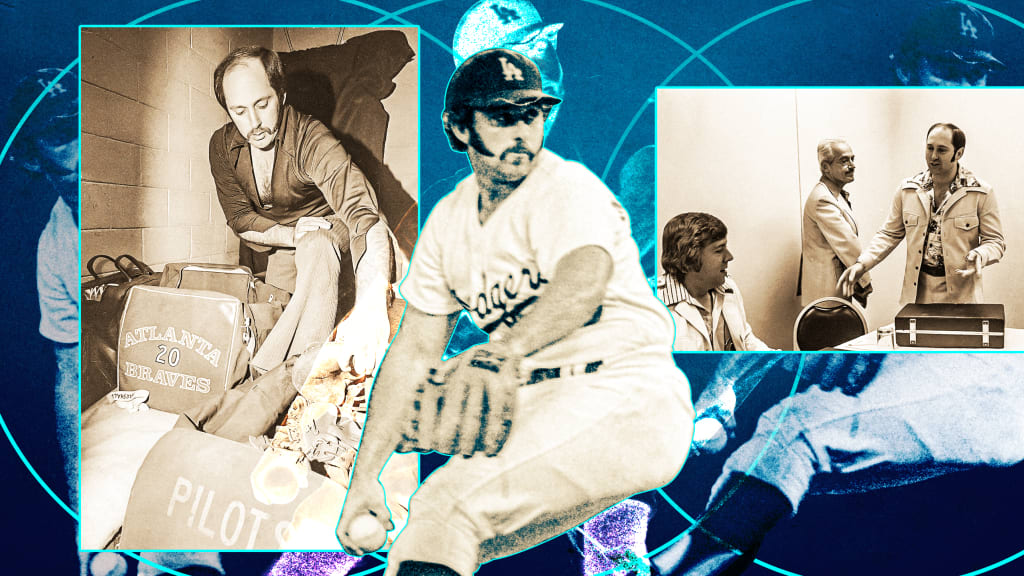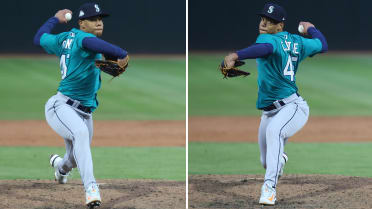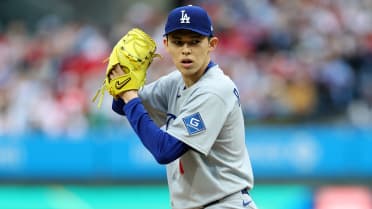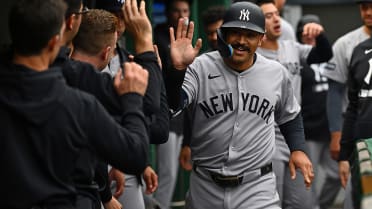
Michael Lynott could have done his assigned science paper on botany or chemistry or biology. He could have studied butterflies, birds or barracudas. He could have learned more about weather patterns or the solar system or earthen materials.
But Lynott was an eighth grade boy. And he wanted to write about baseball.
“If you want to do a paper on baseball,” his teacher told him, “it’s got to be about Mike Marshall.”
This was how, back in 1980, a New Hampshire kid and self-described “marginal, at best, baseball player” came to know more about a pitcher who took a scientific approach to the sport.
Lynott studied a man who had earned a Ph.D. while compiling his ERA, had called baseball a “hobby” and considered education his true craft. He found a Baseball Digest article that detailed how Marshall would chart pitches to every batter and created a database of pitches, counts, locations and results.
“Early day analytics,” Lynott says now.
Lynott dutifully documented the Digest’s report basically verbatim in his own paper and turned it in feeling he had aced the assignment.
He got a C.
“The teacher,” Lynott explained, “wanted the book report to be focused on kinesiology and physiology, for which Marshall had his Ph.D. in both.”
As Lynott learned then, distilling Marshall down to a simple screed in a middle school science class was not an easy task. And now, three years after his death and 50 years after his National League Cy Young season, Marshall remains difficult to summarize succinctly.
Marshall, after all, was one of the most enigmatic figures in baseball history. He was a man who had his own unconventional way of training, of pitching, of dealing with fans and media. A man whose approach to baseball was, in many ways, ahead of its time and in many other ways belonging to no time.
“I’m telling you,” Lynott said. “He had the right message, but he was the wrong messenger.”
Regardless of the brusque nature and eccentricities that made him persona non grata in the pros, it’s clear that, a half century after Mike Marshall reached the peak of his pitching powers, many elements of his message managed to seep through.
***
The numbers are even more staggering now than they were in 1974.
Marshall went 15-12 for the 1974 Los Angeles Dodgers, which would make perfect sense if he were a starter. But no. He compiled that record entirely as a reliever. Marshall made 106 appearances -- to this day 12 more than anybody else in baseball history. He worked 208 1/3 innings -- 29 1/3 more than he had a year earlier with the Expos, when he set a new relief record, and 40 more than any other reliever has before or since.
The Dodgers played 162 games. “Iron Mike,” as Marshall was known then, finished 83 of them. He pitched in a record 13 consecutive games from June 18 through July 2.
To take the ball that often is amazing enough on its own. But of course, the then-31-year-old Marshall was effective, too. He had a 2.42 ERA and an NL-best 21 saves.
“At the moment, he is a strong candidate for the National League's Cy Young Award and Most Valuable Player award,” a United Press International reporter wrote in the midst of that streak, “provided his arm doesn't fall off by August 1, of course.”
His arm intact come October, Marshall “only” finished 11th in the MVP race. But if there were any real question about granting a Cy Young honor to a reliever for the very first time in either league, it didn’t reveal itself much in the voting. Marshall received 17 of 24 first-place votes as the runaway winner over teammate (and conventional starter) Andy Messersmith.
Marshall himself, though, was quite controversial. The baseball establishment did not know what to do with this screwball-tossing screwball who stood an unimposing 5-foot-10, 180 pounds, had zero interest in being a star and once said, “Victory is in the quality of the competition, not just the final score.”
In trading Marshall to the Dodgers prior to that 1974 season, the Expos had become the fifth Major League franchise to punt on Marshall since 1960, when the Adrian, Mich., native had originally signed with the Phillies as a shortstop. Expos skipper Gene Mauch had been the first manager to let Marshall train and pitch his way, and to install him as a relief ace (the term “closer” had not yet come in vogue), and Marshall was so successful that he had finished second in the NL Cy Young voting (to future Hall of Famer Tom Seaver) in 1973. But Marshall’s honest commentary to a reporter about the liabilities of the Expos’ defense and some other unwelcome remarks had rubbed the club the wrong way and hastened his departure.
Thankfully for Marshall, Dodgers skipper Walter Alston was every bit as open as Mauch had been to using Iron Mike wherever, whenever. Marshall pitched on consecutive days 53 times and in both games of a doubleheader once. He entered in the eighth inning 44 times, but also in the sixth on 14 occasions. He pitched at least three innings 22 times and posted a 1.25 ERA across those appearances.
It didn’t matter the situation. Alston used Marshall to mop up (33 appearances up or down three-plus runs), to keep it close (23 appearances with the game tied) and to close it out (27 appearances up one or two runs).
Naturally, reporters would ask Marshall about his unprecedented and unrivaled durability.
“I could explain it to you,” Marshall said that season, “but you don't have the time to listen that long. Besides, you wouldn't understand with your lack of physiological background."
And that right there is, essentially, why Marshall’s message never really pierced baseball’s customs.
"I'm afraid Mike's problem,” former teammate Jim Bouton wrote in “Ball Four,” his famous chronicle of the 1969 Seattle Pilots season, “is that he's too intelligent and has had too much education.”
Marshall developed a reputation as a curmudgeon. He wouldn’t sign autographs for kids because he felt they should be idolizing teachers, not ballplayers. He was unafraid to offer unsolicited advice about where fielders should be positioned (he once said his ’74 season would have been even better had the Dodgers listened to him). He felt the press -- and even the legendary broadcaster Vin Scully -- mocked him. His opinions and methods alienated him.
“That entire year,” Marshall eventually told Sports Illustrated of his Cy Young season, “was not a joy for me.”
The Dodgers lost the 1974 World Series to the Oakland A’s in five games -- and Marshall appeared in every one. Though he famously picked off speedy pinch-runner Herb Washington for a crucial ninth-inning out in Game 2, he surrendered the go-ahead homer to Joe Rudi in the A’s clincher.
When it was over, Mike Marshall did a very Mike Marshall thing: He returned to his alma mater, Michigan State, to prepare a lecture.
That speech, away from the big-league establishment and the cameras, would prove to be a precursor for what awaited Marshall after his playing career.
* * *
Science had made Marshall a pitching machine.
He certainly didn’t appear born to play the role. Marshall was short and stocky and had suffered a bad back injury in a car accident at age 11. Though he had enough baseball talent to sign with the Phillies in 1960 and advance to Double-A, the injury would compel him to switch to pitching. The Phils sold him to the Tigers, where he debuted in 1967, but was demoted soon thereafter.
Marshall became convinced that adopting a screwball could unlock his potential against left-handed batters, but he couldn’t find a club willing to let him throw the supposedly arm-killing pitch. The Tigers made him available to the Seattle Pilots in the 1968 expansion draft, and the Astros purchased his rights a year later, only to trade him to the Expos in June 1970.
Through it all, Marshall, who had married his hometown girlfriend and had three daughters, was dogged in his belief that he could not only succeed with the screwball but avoid injury in the process.
“Throwing screwballs,” he once said, “is safer than throwing pitches that require baseball pitchers to supinate their pitching forearm through release.”
When right-handed pitchers throw a curveball, for instance, they supinate the forearm by turning their right hand clockwise with the thumb up. Marshall’s anatomical studies taught him that pronating the forearm -- rotating the arm counterclockwise in the screwball delivery -- was more natural.
It was not until his time in Montreal that Marshall received the leeway to use his chosen pitch as he saw fit, and it sprung him to enormous heights. He had figured out how to pitch without soreness or stiffness and how to post up in ways that, by today’s especially protective standard, boggle the brain.
“I've never had a sore arm, and I never will have one,” Marshall said during that 1974 season. “The secret is training, and the secret to training is specificity."
Marshall’s appreciation for specificity had developed at Michigan State. There, he studied physical education while playing in the Minors, earning his bachelor’s degree in 1965. He then pursued a doctoral degree in exercise physiology with specialties in kinesiology and motor skill acquisition. He wrote his dissertation on “A Comparison of an Estimate of Skeletal Age With Chronological Age When Classifying Adolescent Males for Motor Proficiency Norms.”
In 1967, Marshall was experiencing shoulder problems. A Michigan State professor suggested he use the high-speed cameras from the school’s agriculture department to figure out what was wrong with his pitching motion. From his study of that 400-frames-per-second film of him throwing his fastball and slider, he was able to determine that the traditional throwing motion was, to him, all wrong.
“I had the audacity to determine that releasing my slider over the top of my index finger caused me to lose 12 degrees of pitching elbow extension range of motion,” Marshall told writer Adam McIntosh of Reviewing the Brew in 2016. “I also had the audacity to determine that by taking my pitching arm laterally behind my body, the brachialis muscle lengthened its coronoid process such that I lost 12 degrees of my pitching elbow flexion range of motion.”
Further, Marshall had the audacity to continue his educational pursuit while rising up the ladder to the Major Leagues. He even served as a consultant to NFL quarterbacks Fran Tarkenton and Billy Kilmer and tennis pro Stan Smith.
Through it all, Marshall’s best and most interesting test subject was himself. And no matter how many people dismissed him as a kook along the way, his success eventually spoke for itself.
“We respect him for what he does,” teammate and 1974 NL MVP Steve Garvey said that year.
Alas, Marshall would never again quite reach the heights he hit in 1974. The following season, he tore cartilage in his ribs and pitched inconsistently. His role as a player representative drew the ire of ownership and led to him being dealt to the Braves in 1976. From there, he bounced around to the Rangers (who tried him briefly as a starter in 1977), then the Twins. Battling knee issues and nearing the completion of his Ph.D., he briefly retired before the 1978 season, only to join the Twins in mid-May and have his best season since the Cy Young year.
Marshall ended up staying with Minnesota into the 1980 season. But, in the midst of high tensions between owners and players, his union rep status ruffled feathers again and he struggled to find work after the Twins released him midyear. He ultimately landed with the Mets for the tail end of the 1981 season, but he was released at year’s end and was cut by the Expos the following spring.
That was it for Mike Marshall -- not just as a player but as a Major League presence. Though he wrote letters to every organization offering his services, not one hired him as a coach or consultant.
“They’re still teaching the same motion of the first guy who won a ballgame,” he told the Kansas City Star in 2007. “There’s not one of them who knows anything of science. They think Sir Isaac Newton invented the Fig Newton.”
Ultimately, Marshall went back to the place where his intellect was most appreciated.
He went back to college.
* * *
Despite that C on his science report, Michael Lynott was able to complete eighth grade and then high school. He applied to Saint Leo University, a private Catholic school north of Tampa, Fla., where he planned to play baseball.
So imagine his surprise soon after, when the school announced its new baseball coach for the 1985 season:
Dr. Mike Marshall.
“It was serendipitous,” Lynott says now.
Lynott remembers the first meeting in which Marshall told the assembled players, “I’m a 5-8 [the official listings of Marshall’s height may have been generous] chubby bald guy, and I won the Cy Young Award. I outworked, outsmarted, did whatever I had to do to get where I wanted to go. Your job is to be the best you can be.”
Basically banished by affiliated baseball, Marshall could teach as he pleased at a place like Saint Leo.
“I went down there, and I don’t even think I knew that much about Mike Marshall,” says George Rodrique, a pitcher on that team. “Obviously I was excited to be taught by a former Major Leaguer, a former Cy Young winner. We were all just sort of fascinated by the prospect. Then when we met him, we’re like, ‘This guy is on another level.’ I’ve never come across anybody like him before or since.”
At first, pitchers like Rodrique were skeptical -- to put it lightly -- of what Marshall was teaching them. His research-based “Marshall Pitching Motion” has to be seen to be believed. The pitcher stands with his toes facing the batter, pendulum swings the pitching hand to rotate the ball over his head and throws it home with a pronation of the arm.
If you’ve watched, well, any pitcher ever, this motion looks wrong. But Marshall insisted to his players at Saint Leo -- and to anyone else who would listen -- that the motion would eliminate arm injuries.
“We were in denial, initially,” Rodrique said. “We thought, ‘Oh, this is ridiculous, we’re throwing with the wrong foot and pushing the ball instead of throwing it.’ But he was so intellectually beyond anything I had ever encountered. I never had an arm problem after that. Never. It really annoyed us to hear all the external critiques and dismissals. We were like, ‘Bro, it may look ridiculous, but it works.’”
Beyond the unusual motion, Marshall also had his pitchers throw iron balls that weighed up to 15 pounds in order to strengthen their arms. He captured their throwing motions with the kind of slow-motion, high-resolution video that he swore saved his arm in the 1960s.
“He was a scientist to the core,” Lynott says. “He was a prideful guy and didn’t give a [bleep] whether people accepted it or not. He was an open book, but he wasn’t going to go out and sell it.”
Instead, Marshall taught it -- first at Saint Leo, then at Henderson State, then at West Texas A&M, all Division II schools. He ultimately settled in Zephyrhills, Fla., where he ran Dr. Mike Marshall’s Pitching Coach Services for many years. He had one protégé, a right-handed pitcher named Jeff Sparks, briefly pitch for the Tampa Bay Devil Rays in 1999-2000, but that was as close as he came to broaching the big leagues again.
Still, Marshall undoubtedly had an impact on people like Lynott, who says his 30-plus-year career as a trial lawyer was directly shaped by what he learned from “Doc” about preparation and time management.
“He probably would have gotten a lot more pub if he got along with people better,” Lynott said. “It’s a shame that he isn’t more revered.”
Marshall’s youngest daughter, Kerry, wants the world to know her famously gruff father had a softer side.
“My dad wasn’t this mean old bear that didn’t sign autographs or give interviews,” Kerry said. “He just was so focused on being a teacher and learning. He would say so many times that teaching was his passion but that it wouldn’t make him enough money. So being a ballplayer paid a lot more, and that’s why he played.”
Needless to say, Marshall did not have great things to say about the baseball establishment. And yet, when you look around the game today, you can see the ways the establishment came around to embracing some of the things Doc espoused decades ago.
High-speed cameras are everywhere. Weighted balls (albeit not 15-pound ones) are ubiquitous. “Spin axis,” which Marshall’s students strived to perfect while throwing trash can lids in the backyard of a nondescript home on an unpaved Florida road, is now observed and documented for the masses.
“Back in the 1970s,” said Kerry Marshall, “nobody wanted to listen to his techniques or how he was doing statistics.”
Marshall passed away in 2021, at age 78. All these years after his Cy Young season and all these years after Lynott wrote that science report, Marshall remains worthy of study.
“The guy could have done anything and been anything,” Lynott said. “But he dedicated it all to baseball."
Anthony Castrovince has been a reporter for MLB.com since 2004.




